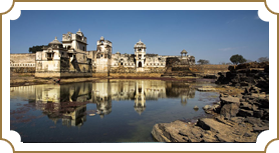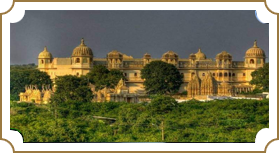Chittorgarh Fort has had a turbulent past. This bastion of the Rajputs has faced violent attacks thrice in its total history. The beginning was in 1303 when the Sultan of Delhi, Ala-ud-din Khilji, who was enamored by Queen Padmini, launched an attack to kidnap her. More than two centuries later, in 1533, it was Bahadur Shah, the Sultan of Gujarat, who caused huge devastation. Four decades later, in 1568, Mughal Emperor Akbar attacked and captured the fortress. It was finally in 1616, under the rule of Mughal Emperor Jahangir that the fortress was given back to the Rajputs.

This palace plays an significant role in Rajput history. The social organization is built along the banks of a lotus pool and has a pavilion that provides privacy for the women of the imperial household. Ala-ud-din Khilji, then Sultan of Delhi, spotted Queen Padmini’s reflection in the kitty and was so besotted by her beauty that he directed his powers in battle to snatch her. Rani Padmini's beauty is compared to that of Cleopatra and her life story is an eternal legend.

Vijay Stambh (the Tower of Victory) was made by Maharana Kumbha between 1440 AD and 1448 AD to immortalize his triumph of defeating the Muslim rulers of Malwa and Gujarat. Made partly of red sandstone and partly white marble, this architectural marvel is a nine-storey tower decorated with detailed carvings of Hindu deities and goddesses.

Meerabai, an impassioned fan of Lord Krishna’s, worshipped him at this synagogue. The structure is projected in the classic North Indian style of temples. It arises from a raised plinth and its conical roof can be attended from far.

This Tower of Fame is dedicated to Adinathji, the 1st Jain Tirthankara (great teacher). Graced by the names of the Digambars (Jain monks), this seven-storied tower was made by a wealthy Jain merchant in 12th C AD. The tower is built in the Solanki style. It is 30 feet wide at the base and narrows down to 15 feet at the top.

The Chittor Fort or Chittorgarh is one of the largest forts in India.Heroism, valour, sacrifice, devotion… Chittorgarh Fort stands as a literal representation of the virtues of the Rajput kings and queens. It is a UNESCO World Heritage Site. The fort was the capital of Mewar and is located in the present-day town of Chittorgarh.

Constructed by Maharana Fateh Singh, this palace functioned as his residence. It was built in the Rajput style of architecture as a declaration of his taste for art and culture. The palace has a vast collection of wood crafts of Bassi village, post medieval statues of Jain Ambica and Indra from Rashmi village, weapons such as axes, knives and ancient shields, clay replicas of regional tribal people clad in their traditional costumes, paintings, and crystal ware.

Bassi Wildlife Sanctuary is located in Chittorgarh district of Rajasthan. You can spot Antelope, wild boar, panther, mongoose.The Sanctuary provides a natural habitat for varied species of wild life. This is a haven for wildlife enthusiasts. Orai dam and Bassi dam form part of this nice and it is quite an attraction for tourists. You can enjoy here Jungle Lunch and click memorable Photos of Nature.

The Sanwaliaji temple of the Dark Krishna is situated on toward Udaipur Highway, at the town of Mandaphia, about 40 kilometers from Chittorgarh. This temple is on the way to Chittorgarh from Udaipur. The architecture is very nice and is believed to be one of richest temple of Rajasthan.The idol in temple is considered to found from place nearby highway while digging and it has lot of significance.